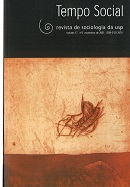Youngsters and their routes in town
DOI:
https://doi.org/10.1590/S0103-20702005000200008Keywords:
Youth circuits, Juvenile culture, Metropolis, Urban ethnographyAbstract
This article presents the results of a research on youth and their cultural and leisure practices, sociability networks and exchange relations (as well as those of conflict) in the context of urban São Paulo. After introducing and discussing the terms "urban tribes and juvenile culture", I propose another term, "juvenile circuits" to deal with the theme. Instead of emphasizing the fact that they are youths, which would supposedly link a diversity of manifestations to a common denominator, the idea is to highlight their insertion in the urban scenario through an ethnography of the spaces where they circulate and meet, the occasions where there is conflict, and the partners with whom they establish exchange relationships. By adopting this approach, I intend to articulate two elements that are present in this dynamic: the behaviors and the spaces, institutions and urban equipment. The idea is to call the attention to (1) sociability and not to consumption and styles of expression linked to the generational issue, (2) to the permanence and regularity rather than fragmentation and nomadism.Downloads
References
ABRAMO, Helena W. (1994), Cenas juvenis: punks e darks no espetáculo urbano. São Paulo, Página Aberta.
BERMAN, MARSHALL. (1989), Tudo que é sólido desmancha no ar. São Paulo, Companhia das Letras.
CARDOSO, Ruth & SAMPAIO, Helena. (1995), Bibliografia sobre juventude. São Paulo, Edusp.
DA MATTA, Roberto. (1979), Carnavais, malandros e heróis: para uma sociologia do dilema brasileiro. Rio de Janeiro, Jorge Zahar.
FEIXA, Carles. (1998), De jóvenes, bandas y tribus: antropología de la juventud. Barcelona, Ariel.
FEIXA, Carles. (2004), “Los estudios sobre culturas juveniles en España – 1960-2004”. Revista de Estudios de Juventud, 64, mar., Madrid.
FERREIRA DOS SANTOS, Nelson et al. (1985), Quando a rua vira casa: a apropriação de espaços de uso coletivo em um centro de bairro. São Paulo, Projeto Editores Associados/Ibam.
GOLDMAN, Márcio. (1999), Alguma antropologia. Rio de Janeiro, Relume-Dumará.
GUERREIRO, Goli. (1994), Retratos de uma tribo urbana: rock brasileiro. Salvador, Centro Editorial e Didático da UFBA.
HALL, Stuart & JEFFERSON, Tony (orgs.). (1976), Resistance through rituals: youth subcultures in post-war Britain. London, Hutchinson.
JACOBS, Jane. (1992), The death and life of great American cities. New York, Vintage Books, Random House.
MAFFESOLI, Michel. (1987), O tempo das tribos: o declínio do individualismo nas sociedades de massa. Rio de Janeiro, Forense Universitária.
MAGNANI, José Guilherme C. (1992), “Tribos urbanas, metáfora ou categoria?”. Cadernos de Campo – Revista dos alunos de pós-graduação em Antropologia. Departamento de Antropologia, FFLCH/USP, São Paulo, 2 (2).
MAGNANI, José Guilherme C. (2002), “De perto e de dentro: notas para uma etnografia urbana”. Revista Brasileira de Ciências Sociais, 17 (49): 11-29.
MAGNANI, José Guilherme C. & TORRES, Lílian. (2000), Na metrópole: textos de antropologia urbana. 2. ed. São Paulo, Edusp/Fapesp.
NILAM, Pam. (2004). “Culturas juveniles globales”. Revista de Estudios de Juventud, 64, mar., Madrid.
PAIS, José Machado & BLASS, Leila (orgs.). (2004), Tribos urbanas: produção artística e identidades. São Paulo, Annablume/Capes.
Downloads
Published
Issue
Section
License
Copyright (c) 2015 Tempo Social

This work is licensed under a Creative Commons Attribution-NonCommercial 4.0 International License.


